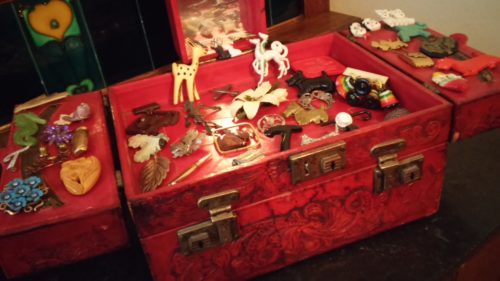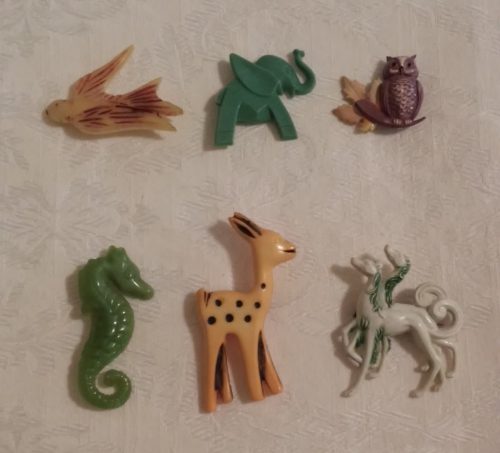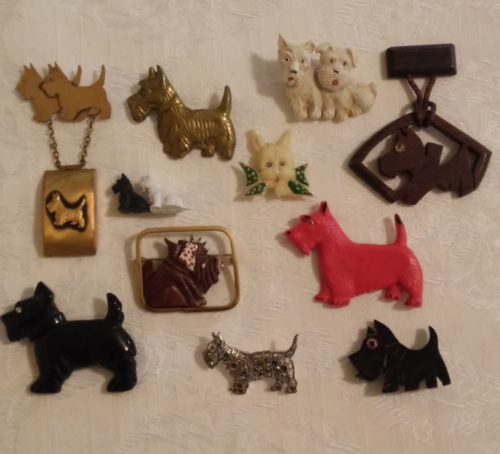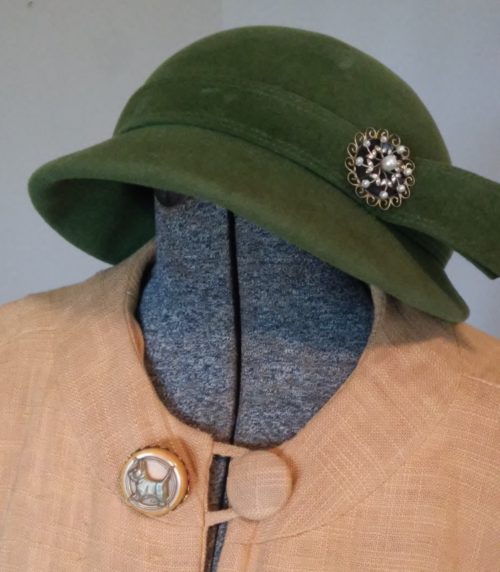Spring is inching closer and I’m tidying up, and that means organizing my jewelry. I don’t have a ton of bakelite like other vintage girls, although I have some and hold it very dear, but I do have a lot of vintage pins in a variety of materials. Several of them I’ve had since high school! The beautiful thing about pins is that no matter how my weight fluctuates, unlike my vintage dresses and shoes, my pins always fit. Sometimes my necklaces even look weird when my neck and chin get fatter. Anyone else have this problem?
Vintage Pins of Antique Brooches
I’ve sorted my pins in types and sorry, no I’m no selling them. I just wanted to share my collection and love of vintage pins. But first a little history. While you can interchange the names, a pin is generally smaller and can have various shapes where a brooch is generally larger and traditionally made in a circular or oval shape, usually worn at the neckline and can take the place of a button or closure. I usually think of their differences in this way, and for my vintage 1920s-1950s purposes, I wear mostly pins and think of brooches as Victorian or earlier, though as you will see, I clearly have pins that could be considered brooches.
Wikipedia has an excellent history and goes into depth on the evolution of brooches and pins by region and era. But this sums it up nicely: “A brooch /ˈbroʊtʃ/ or, in US English also /ˈbruːtʃ/ is a decorative jewelry item designed to be attached to garments, often to hold them closed. It is usually made of metal, often silver or gold or some other material. Brooches are frequently decorated with enamel or with gemstones and may be solely for ornament or serve a practical function as a clothes fastener. The earliest known brooches are from the Bronze Age. As fashions in brooches changed rather quickly, they are important chronological indicators. Many of the ancient European brooches found in archaeology are usually referred to by the Latin term fibula.”
Interestingly, Wikipedia doesn’t talk about vintage pins past the Art Deco period which I imagine most of our collections are of this later decades. But here’s a fun fact from The LOVE TO KNOW site, Pins article written by Edward Tenner says: “Paris was the center of medieval pin manufacturing; by the seventeenth century, though, pin making was the leading industry of Gloucester, England. Less valuable than needles, metal pins were small luxuries in early modern Europe; pin money was originally a bonus given to a merchant on concluding a deal for his wife’s pins.”
I found this most interesting because my mother used the term “pin money” while I was growing up. I don’t much hear it any more, but it referred to extra money a woman had that she could spend on whatever she wanted. Now, most of us make our own money and need not depend on a man for “pin money” but since my writing is not my main source of income (yet), perhaps my book sales moola could be considered my modern pin money or what everyone calls their “side hustle” now.
My Animal Vintage Pins
As far as I could find, the use of animals in brooches has been used throughout the ages. All of these I have found at local antique stores and vintage shops and none of them I paid over $15 dollars for. I probably wear the yellow faun more than any of the others. The fancy double dogs looked a little like my daughter’s college grad-year animal symbol the Pegasus (sans the wings). She’s far away in Massachusettes (where I bought the pin in a basement antique store), but it reminds me of her. Which one of mine if your favorite?
My Scottie Dog Vintage Pins
Although I technically should have included the Scotties with the animals, I have more Scottie Dog pins than any other. Seven years ago, we got our beloved Maisie Scottie and since then, not only do my husband and I collect Scottie bric-a-brac, our friends tend to give us Scottie everything for birthdays and Christmas. At last year’s Christmas party, our kids created a game: Count the Scotties, that included statues, art, chotskies (tchotchke), candle-holders, napkin holders, and any jewelry being worn at the time. I think it was close to fifty! It’s kind of interesting that the bulk of the pins face right when worn. Guess which ones I wear the most? What’s your favorite out of the group?
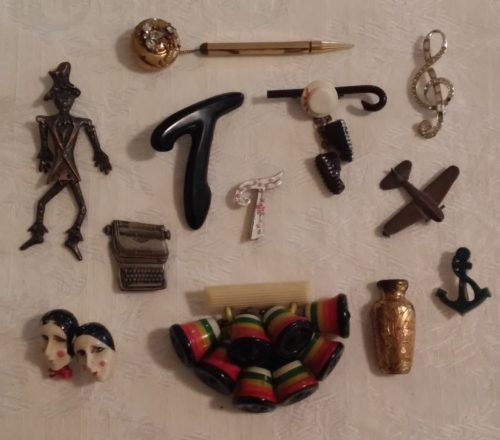
My Random Object & Things Vintage Pins
Most of these pins have been gifts and there is a wonderful variety. The one I love the most is the bakelite cluster of bells. I happened upon it at an antique store and although, it’s the most I ever paid for a pin, $40, it was a great bargain. Next to it, the vase can actually hold a tiny flower, and I wear my airplane when I fly and my typewriter when I go to my weekly writer’s critique group. Check out the pen pin (across the top). There is a chain that winds up into the circle, how clever is that?
Do you see my two “T” pins. I grew up watching Laverne & Shirley,( and Laverne forever reminds me of my mom), and I loved her iconic “L” on her clothing. Here’s Penny Marshall’s story of how that came about. The fashion choice seems rooted in 1950s fads for sure: “I was looking for a short cut as I sifted through the vintage clothing that the wardrobe department had collected from the 1950s. I came across a sweater with an initial sewn in the upper left corner. It suddenly dawned on me how I could save time. Make the initial an “L” and then everyone would remember that my name is Laverne. The wardrobe department took my suggestion and quickly changed the letter to an “L” and the rest is history.”
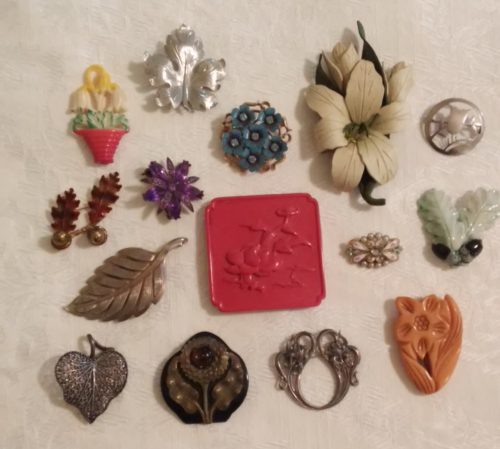
Flowers & Leaves Vintage Pins
This is even bigger than my Scottie Dog collection of vintage pins and encompasses metal, bakelite, rhinestones, enamel, and even leather. The big tropical hibiscus is soft leather. Several of these I’ve re-purposed as pins because they were so pretty and I didn’t want to let them sit in a drawer. One was a light-pull (which is an ornament found on the end of a chain or string to turn off a light or fan–they’re regaining popularity!), and a few of my pins were from dress or shoe clips that I only had one-half of, or a belt clip. Since I do a lot of swing dancing belts aren’t always a good option as a partner’s hand can get stuck on them. I turned the very pretty red square one into a pin!
Vintage Pins Aren’t Just for Sweaters & Blouses
In the winter months, I wear a lot of hats, mostly wool beret and some vintage cloches, a few 1930s & 1940s styles thrown in, and I’ve found it fun to add a small pin to the beret or if the hat has a band to add it at a jaunty angle for just that extra vintage look. I’ve also used my pins at the top button on a vintage jacket, as well as an accent on my purses or on the knot of a scarf. I use a lot of vintage fashions descriptions in my writing and, for the life of me, I can’t remember if my any of my characters wear any vintage pins. I hope so, if not I’ll half to remedy that in my next novel.
::
Do you wear vintage pins? What are some of your favorites and where have you found them? Do you have tips on fixing broken ones or getting them at the correct angle on your clothing? Do any of your pins elicit memories or have meaning for you?
 Tam Francis is a writer, blogger, swing dance teacher, avid vintage collector, and seamstress. She shares her love of this genre through her novels, blog, and short stories. She enjoys hearing from you, sharing ideas, forging friendships, and exchanging guest blogs. For all the Girl in the Jitterbug Dress news, give-aways, events, and excitement, make sure to join her list and like her FB page! Join my list ~ Facebook page
Tam Francis is a writer, blogger, swing dance teacher, avid vintage collector, and seamstress. She shares her love of this genre through her novels, blog, and short stories. She enjoys hearing from you, sharing ideas, forging friendships, and exchanging guest blogs. For all the Girl in the Jitterbug Dress news, give-aways, events, and excitement, make sure to join her list and like her FB page! Join my list ~ Facebook page

